#lesbian feminist history
Explore tagged Tumblr posts
Text

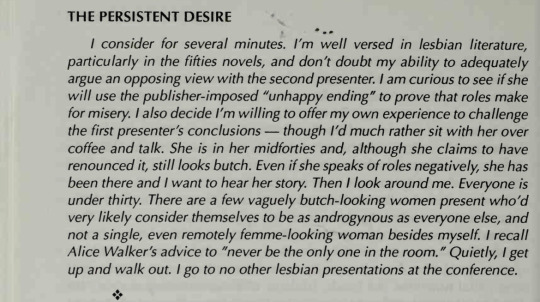
"The main justification for invalidating butch-femme is that its an imitation of heterosexual roles and, therefore, not a genuine lesbian model. One is tempted to react by saying "So what?" but the charge encompasses more than betrayal of an assumed fixed and "true" lesbian culture. Implicit in the accusation is the denial of cultural agency to lesbians, of the ability to shape and reshape symbols into new meanings of identification. Plagiarism, as the adage goes, is basic to all culture.
In the real of cultural identity, that some of the markers of a minority culture's boundaries originate in an oppressing culture is neither unusual nor particularly significant. For instance, in the United States certain kind of bead- and ribbon work are immediately recogniziable as specific to Native American cultures, wherein they serve artistic and ceremonial functions. Yet beads, trinkets, ribbons, and even certain "indian" blanket patterns were brought by Europeans, who traded them as cheap goods for land. No one argues that Indians out to give up beadwork or blanket weaving, thus ridding themselves of the oppressors symbols, because those things took on a radically different cultural meaning in the hands of Native Americans. Or consider Yiddish, one of the jewish languages. Although Yiddish is written in Hebrew characters and has its own idioms and nuances, its vocabulary is predominantly German. Those who speak German can understand Yiddish. Genocidal Germanic anti-Semitism dates back to at least the eleventh century. Yet East European Jews spoke "the oppressors language," developing in it a distinctive literary and theatrical tradition. Why is it so inconceivable that lesbians could take elements of heterosexual sex roles and remake them?
*
It is June 1987, and I am sitting in a workshop on "Lesbians and Gender Roles" at the annual National Women's Studies Conference. It is one of surprisingly few workshops on lesbian issues, particularly since, at a plenary session two mornings later, two thirds of the conference attendees will stand up as lesbians. Meanwhile, in this workshop the first speaker is spending half an hour on what she calls "Feminism 101," a description of heterosexual sex roles. Her point in doing this, she says, is to remind us of the origin of roles, "which are called butch and femme when lesbians engage in them." She tells us the purpose of her talk will be to prove, from her own experience, that "these roles are not fulfilling" for lesbians. She tells us that the second speaker will use lesbian novels from the 1950s to demonstrate the same thesis. And, indeed, the second speaker has a small stack of 1950s "pulp paperbacks" with her, many of them the titles that, when I discovered them in the mind-1970s, resonated for me in a way that the feminist books published by Daughters and Diana Press did not.
I consider for several minutes. I'm well versed in lesbian literature, particularly in the fifties novels, and don't doubt my ability to adequately argue an opposing view with the second presenter. I am curious to see if she will use the publisher-imposed "unhappy ending" to prove that roles make for misery. I also decide I'm willing to offer my own experience to challenge the first presenters conclusions- though I'd much rather sit with her over coffee and talk. She is in her midforties and, although she claims to have renounced it, still looks butch. Even if she speaks of roles negatively, she has been there and I want to hear her story. Then I look around me. Everyone is under thirty. There are a few vaguely butch-looking women present who'd very likely consider themselves to be as androgynous as everyone else, and not a single, even remotely femme-looking women besides myself. I recall Alice Walker's advice to "never be the only one in the room." Quietly, I get up and walk out. I go to no other lesbian presentations at the conference."
“Recollecting History, Renaming Lives: Femme Stigma and the feminist seventies and eighties" by Lyndall MacCowan, The Persistent Desire, (edited by Joan Nestle) (1992)
#the persistent desire#Lyndall MacCowan#Joan nestle#lesbian#lesbianism#butch and femme#butchfemme#butch and femme history#butch lesbian#femme lesbian#butch history#femme history#lesbian history#lesbian culture#lesbian feminism#lesbian feminist history#lgbt history#queer history
119 notes
·
View notes
Text
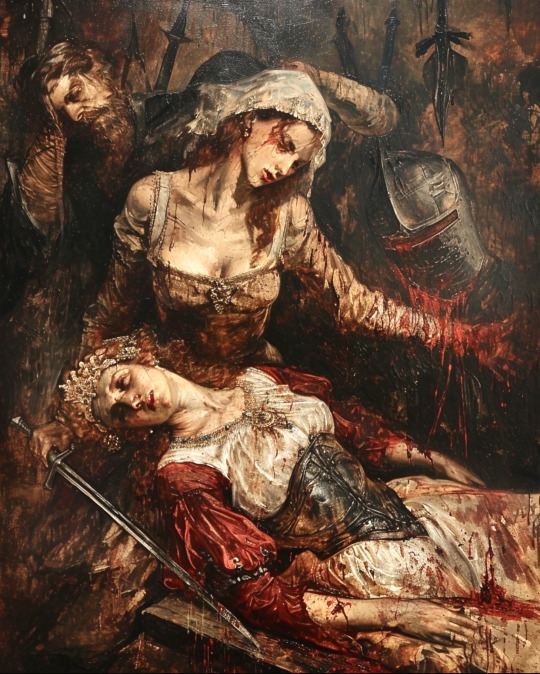
© Breed My Darkness
#painting#art#artblr#art history#oil on canvas#oil painting#classical art#goth#femme#gothic#wlw#lesbian#strong female character#feminist#feminine#dark feminine aesthetic#dark feminine energy#classic academia#dark academia#artist#art community#art gallery#art blog
3K notes
·
View notes
Text
My university history course literature includes a book on women's history. Entirely written by two men. It has a whole chapter on "transgender history". The first person they bring up is Ulrika Eleonora Stålhammar, a swedish woman from the late 17th- early 18th century who started dressing as a man and took a male name to marry her wife Maria Lönman. After ten years or so she started presenting herself as a woman again. These men are SO confused as to why. Why would she ever stop living as a man? And if she was a lesbian, why bother living as a man in the first place, considering female homosexuality was never formally outlawed in Sweden? The entire time they refer to her as a trans man.
Why oh why could a woman in the 18th century possibly be uncomfortable living as a woman? Why oh why would a woman in the 18th century not just live openly as a lesbian? What reason could she POSSIBLY have had to pretend to be a man? Nah, no critical thinking here. She was obviously a man all along, that's the only reasonable explanation. This is what they're making university students read for history.
Stop discrediting these brave women. I know you think you're being inclusive and progressive by imagining they were Actually trans, but you're not. All you're doing is perpetuating the myth that all women are and were submissive and content in their role as second class citizens (if even that). If every female person who was gender nonconforming in the Olden Times was actually a man all along then the actual women didn't have it that bad, right? They never rebelled against their societal roles before the women's voting right movements, right??
1K notes
·
View notes
Text
It's concerning that this is now an LGB and women's issue now, but I really encourage people to begin purchasing USB drives or external hard drives and saving digital research on things such as gay & lesbian history, screenshots of tweets that might be important, homosexual and bisexual research, women's history, radical feminist books or PDFs, and really just anything that is at risk of being "corrected" by gender ideology or made inaccessible by academic publishers.
We need to save these things in a hard copy format as opposed to just using internet archive or taking Sci-hub for granted, because these organizations are experiencing heavy lawsuits. Additionally, it's becoming common for LGB and gender nonconformity history and research to be "rewritten" by gender ideologists. Actually, this is even true for past research and history on transvestism and transsexualism, too, in addition to things such as sex dysphoria, etc.
I bought three 64GB USBs for just $25. If you can't afford an external hardrive, buy some different colored USBs and start building your own library. We need to preserve this information and decentralize it as much as possible. It's worrisome enough that we rely on digital archives this much just generally, especially with the advent of AI and government and corporate attempts to eliminate data privacy and control.
This is a women's rights issue and an LGB issue now.
#human rights#LGB#LGBT#gay history#protect gay history#women's history#women's rights#LGBT history#gender critical#radical feminist#dataprotection#data protection#references#resources#activism#gay activism#lesbian culture#lesbian rights#lesbian history#gay rights#adult human female#feminism
1K notes
·
View notes
Text
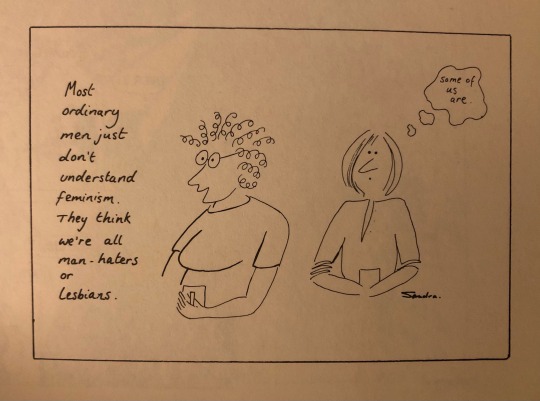
Source: Women Draw 1984 - art by Sandra Warne
#feminist#feminisim#lesbian history#lavender menace#lesbian art#lesbian comic#image#lgbt#photo#lesbian#art#perosnal
1K notes
·
View notes
Text

The best study companion <3 I've been spending long days reading feminist and lesbian lit, writing endless notes to the point I've messed up my back (ah, chronic pain, what a delight). Serves me for not taking breaks and stretching. Do your stretches y'all! Learn from me ^^' P.s. that card in the upper left was handmade by my gf.
96 notes
·
View notes
Note
How’s it feel knowing trans people will exist long after your sad self is forgotten?
We’re here, we’re queer, you can’t get rid of us.
Not only do I see the self-centering tendencies of gendies, but I also educate myself in their unstable family relationships, trauma, comorbid mental illnesses, and so forth.
Normalizing and celebrating a mental illness is the very thing that sets apart the TQ-alphabet weirdos from LGBs.
And yes, y'all are very weird/queer
Oh and at this point. It's natural selection at it's finest 🫶🏽
Have a good one.

#radblr#lesbian#radical feminism#radical feminist safe#radical feminists do interact#radical feminist community#radicalfeminist#terfsafe#relationship#lgb love#lgb pride#lgb history#radfeminism#radical feminist#divine feminine#feminism#global feminism#terfsruntumblr#terfbreaking#terfblr
63 notes
·
View notes
Text
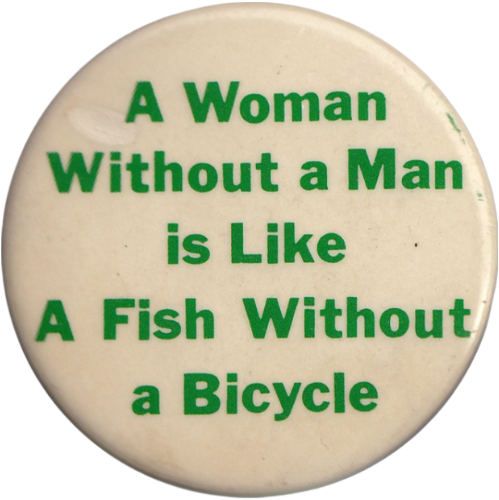
source
#a woman without a man is like a fish without a bike#the future is female#so true#lesbian pride#wlw#wlw art#i ♥️ women#pro women#pro choice#protect abortion#feminist#lesbian history#archive#button png#random pngs#retro pins#green aesthetic#retro buttons#button pins#pins#badges
30 notes
·
View notes
Text
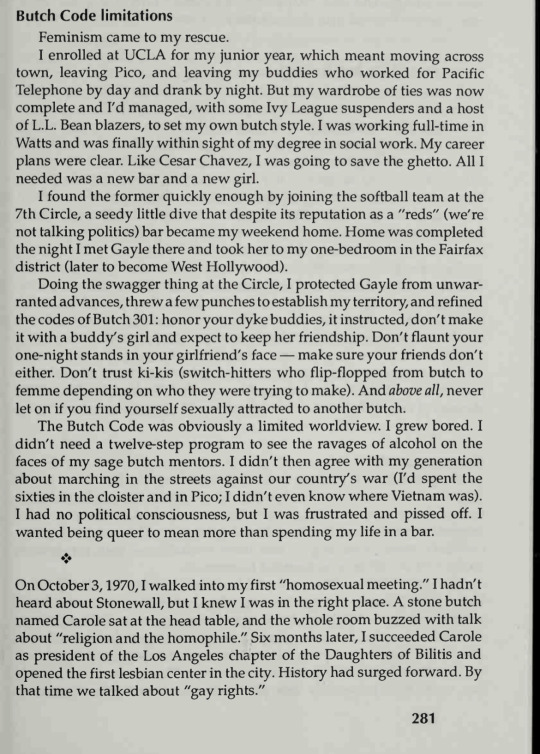
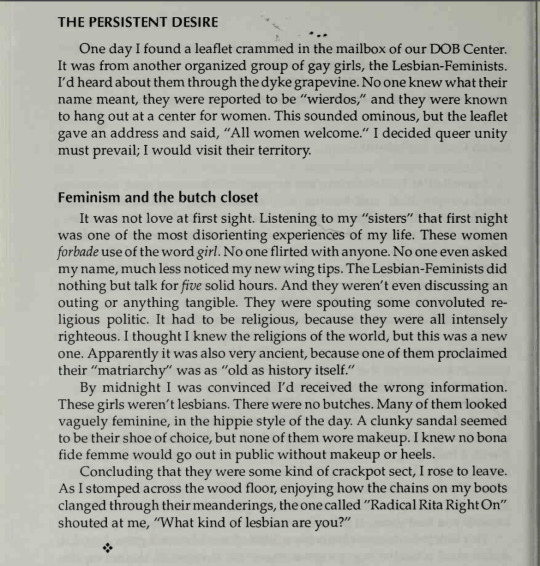
"Butch Code Limitations Feminism came to my rescue. I enrolled at UCLA for my junior year, which meant moving across town, leaving Pico, and leaving my buddies who worked for Pacific Telephone by day and drank by night. But my wardrobe of ties was now complete and I'd managed, with some Ivy League suspenders and a host of L.L. Bean blazers, to set my own butch style. I was working full-time in Watts and was finally within sight of my degree in social work. My career plans were clear. Like Cesar Chavez, I was going to save the ghetto. All I needed was a new bar and a new girl.
I found the former quickly enough by joining the softball team at the 7th Circle, a seedy little dive that despite its reputation as a "reds" (we're not talking politics) bar became my weekend home. Home was completed the night I met Gayle there and took her to my one-bedroom in the Fairfax district (later to become West Hollywood).
Doing the swagger thing at the Circle, I protected Gayle from unwaranted advances, threw a few punches to establish my territory, and refined the codes of Butch 301: honor your dyke buddies, it instructed, don't make it with a buddy's girl and expect to keep her friendship. Don't flaunt your one-night stands in your girlfriend's face -- make sure your friends don't either. Don't trust ki-kis (switch-hitters who flip-flopped from butch to femme depending on who they were trying to make). And above all, never let on if you find yourself sexually attracted to another butch.
The butch code was obviously a limited worldview. I grew bored. I didn't need a twelve-step program to see the ravages of alchol on the faces of my sage butch mentors. i didn't then agree with my generation about marching in the streets against our country's war (I'd spend the sixties in the cloister and in Pico; I didn't even know where Vietnam was). I had no political consciousness, but I was frustrated pissed off. I wanted being queer to mean more than spending my life in a bar.
On October 3, 1970 I walked into my first homosexual meeting. I hadn't heard about Stonewall, but I knew I was in the right place. A stone butch name Carole sat at the head table, and the whole room buzzed with talk about "religion and the homophile." Six months later, I succeeded and Carole as president of the Los Angeles chapter of the Daughters of Bilitis and opened the first center in the city. History had surged forward. By that time we talked about "gay rights."
One day I found a leaflet crammed in the mailbox of our DOB Center. It was from another organized group of gay girls, the Lesbian-Feminists. I'd heard about them through the dyke grapevine. No one knew what their name meant, they were reported to be "weirdos," and they were known to hang out at a center for women. This sounded ominous, but the leaflet gave an address and said, "All women welcome." I decided queer unity must prevail; I would visit their territory.
Feminism and the Butch Closet It was not love at first sight. Listening to my "sisters" that first night was one of the most disorienting experiences of my life. These women forbade use of the word girl. No one flirted with anyone. No one even asked my name, much less noticed my new wing tips. The Lesbian-Feminists did nothing but talk for five hours. And they weren't even discussing an outing or anything tangible. They were spouting some convoluted religious. It had to be religious, because they were all intensely righteous. I thought I knew about the religions of the world, but this was a new one. Apparently it was also very ancient, because one of them proclaimed their "matriarchy" was as "old as history itself."
By midnight I was convinced I'd received the wrong information. These girls weren't lesbians. There were no butches. Many of them looked vaguely feminine, in the hippie style of the day. A clunky sandal seemed to be their shoe of choice, but none of them wore makeup. I knew no bona fide femme would go out in public without makeup or heels.
Concluding that they were some kind of crackpot sect, I rose to leave. As I stomped across the wood floor, enjoying how the chains on my boots clanged through their meanderings, the one called "Radical Rita Right On" shouted at me, "What kind of lesbian are you?"
-“Butches, Lies, and Feminism" by Jeanne Cordova, The Persistent Desire, (edited by Joan Nestle) (1992)
#the persistent desire#Jeanne Cordova#lesbian#lesbianism#lesbian history#lesbian lit#gay rights history#lesbian feminism#lesbian feminist history#Butch lesbian#femme lesbian#butch lesbian history#lgbt#lgbtq+#gay rights
67 notes
·
View notes
Text


Zofia Sadowska (deceased)
Gender: Female
Sexuality: Lesbian
DOB: 28 February 1887
RIP: 7 March 1960
Ethnicity: White - Polish
Occupation: Doctor, activist, feminist
Note: In 1914, she was the first woman and the first Polish woman to defend her doctorate.
#Zofia Sadowska#lgbt history#lgbt#lgbtq#lesbian history#female#lesbian#1887#rip#historical#white#polish#doctor#activist#feminist#first#popular#popular post
218 notes
·
View notes
Text
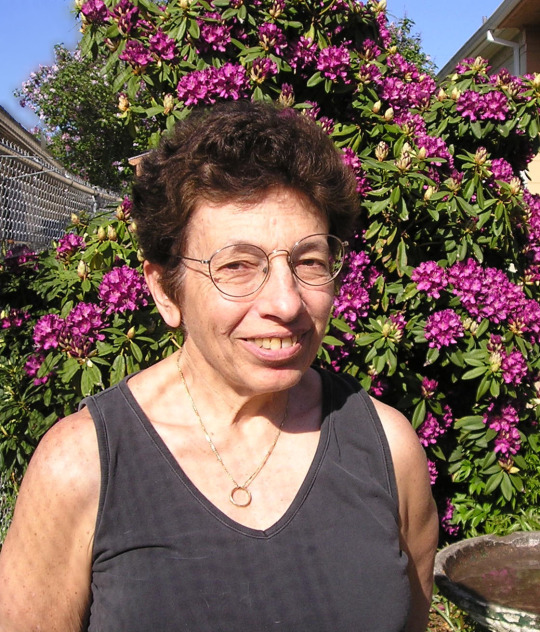
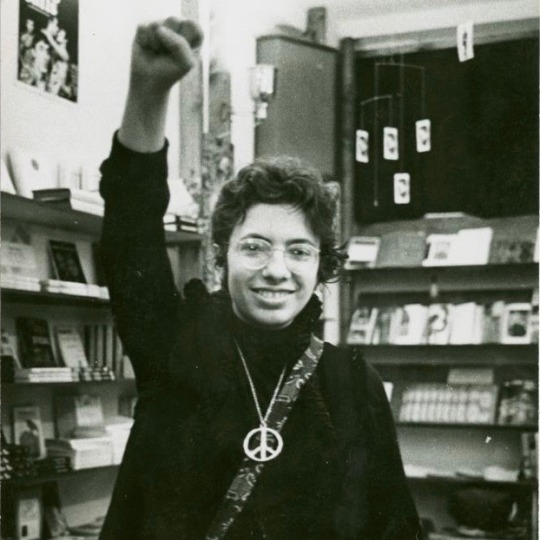
Martha Shelly is a Jewish activist lesbian and feminist.
She was involved in many forms of activism including the Vietnam anti war protests and was an ally to the Black Panthers. She joined the Daughters of Bilitis, a lesbian civil rights group, in 1967, and later went on to become president of the New York chapter. While working as a secretary in the office of fundraising for Barnard College, she joined the Student Homophile League.
After witnessing the Stonewall riots and seeing the public reaction Martha was inspired to organize a protest. With the DOB and the Mattachine Society they organized the first gay protest march in America, shortly after that, they formed the Gay Liberation Front. She became the face of the movement, going on tv programs and speaking at public events.
As a young adult her therapist put her through a conversation therapy of sorts, she insisted she try to be bisexual as to not “give up on half the world in her dating pool”. She tried for a while, getting with other gay men put in this program and went on to date bisexual activist Stephen Donaldson. But after her working with the GLF and getting more involved with her community she accepted herself as a lesbian.
At the time lesbians were considered a threat to the feminist movement. The president of The National Organization for Women Betty Friedan called lesbians in the movement a “lavender menace” and the organization distanced themselves from lesbian causes and even omitted the sponsorship of the DOB. Women from DOB and the GLF, including Martha, joined together to create the group ‘Lavender Menace’ in response. Together, dawning shirts and signs they protested at a NOW event for lesbian causes to be included.
My job was to jump up on the stage and grab the mic. I explained that we were here because lesbians had been excluded, and we wanted to talk about our issues. Then I put it to the audience. "Let's take a vote how many want to continue with the panel discussion? How many want to hear what we have to say?" The women voted overwhelmingly to hear from us. Then other Menaces marched down the aisle and stepped up onto the stage, while a few remained in the audience. A freewheeling discussion ensued. At their next annual conference NOW revised their platform to include lesbian rights.
The group was soon after renamed the Radicalesbians.
Despite members of the group partaking in it, Martha did not consider herself a lesbian separatist. She liked the idea of lesbian only spaces but thought that splitting the gay movement into smaller groups would weaken the movement as a whole.
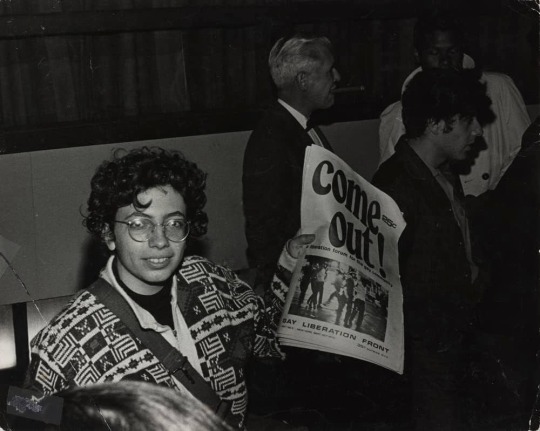
Sources:
We Set the Night on Fire: Igniting the Gay Revolution by Martha Shelley (2023)
Martha Shelley - Wikipedia
#martha shelley#lgbt history#lesbian history#queer history#feminist history#lesbianism#lgbt education#activists#people#feminism#lgbtq community#lesbians in action
260 notes
·
View notes
Text

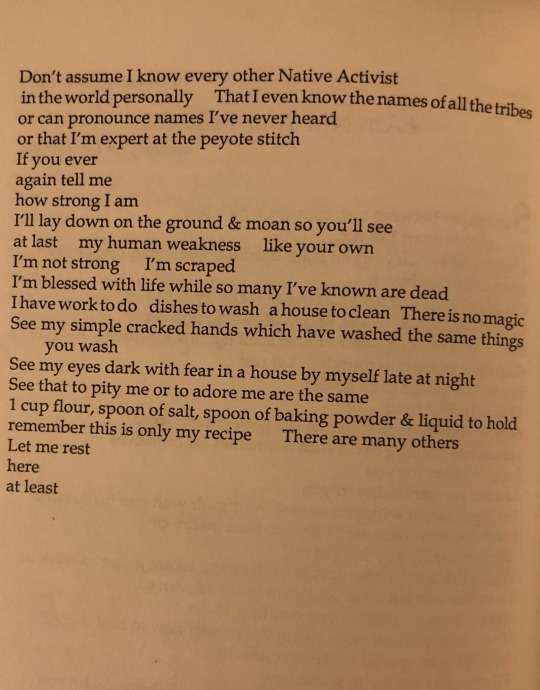
Source: Sinister Wisdom 43/44 ( The 15th Anniversary Retrospective)
#lesbian history#lesbian Native American history#lesbian poetry#Native American poetry#lgbt history#feminist history#lgbt#image#lesbian#photo#art#quote#poetry#personal
190 notes
·
View notes
Text

from Country Lesbians: The Story of Womanshare Collective
they were just like us!
#female separatism#hopefem#women's land#lesbian#lesbian history#lesbians#radical feminist safe#radical feminists do interact#radblr#sisterhood
235 notes
·
View notes
Text
Currently watching some "butchfemme" discourse on Twitter and why do people act like the person viewing the phenomenon through a critical lens for analytical purposes is puritanical, offensive, erasing lesbian history or whatever other term they're using?
Our ability to not evaluate the things we cling to and then be babies about it online is so tiring. You're always going to be yourself but not because something is sensitive to you means that it's not to be discussed lol especially on a platform like Twitter where you have to insert yourself into the conversation and then get mad lol.
Cuz I'm actually liking the thought of how rad fem literature leans to abolishing gender but I also like wondering about seemingly American lesbian butchfemme culture and how that can also play into gender roles despite the power imbalance and hierarchy of heterosexual roles not existing there. Like damn, 2 things can exist at the same time and it's really interesting to think about, personal feelings on it aside.
There was also the line that "masculinity" doesn't belong to men from some rad fem account and I just briefly thought ... isn't that a little weird for a rad fem to say? If femininity doesn't exist, doesn't masculinity not exist either?
Like when I read fanfic, sometimes I can't stand certain themes because they feel like heterosexual shit even though I exclusively read lesbian ships. I tend to leave the things I don't feel interested in alone but maybe because of how things feel a bit "straight" to me is why I avoid it because it feels like gender roles where I don't want any.
Anyways, thoughts? Don't be a reactionary though, save that shit for Twitter.
#things that make you go hmmmm#radblr#radical feminism#feminist analysis#rad fem#radical feminist community#radical feminist safe#radical feminists do interact#radical feminists do touch#lesbian#lesbian culture#lesbian history
25 notes
·
View notes
Text
Randomly stumbled upon Vera Hjelt’s wikipedia page and i’m obsessed. She was a teacher, a writer, she founded and managed a factory, she advocated for worker’s rights and was the first female professional inspector in nordic europe AND also a congresswoman (in 1908-1917 !!!!!). On top of everything she was a lesbian and her partner was called FANNY Tavastsjerna. They lived together for 35 years and were buried together.

23 notes
·
View notes
Text
Historical woman- “I freed my people from a draconian dictatorship while also fighting off the king of said dictatorships marriage advances. I spoke 9 languages and was famed for my brains. I taught young girls how to fight and trained them in battle tactics. I lived with my girlfriend all my life, she helped make key decisions with me about the good of our people, took over running when I could not, and fought alongside me in the battle I died in, we were found dying in each others arms after the battle ended”
Male Historians- “SHE WAS A HOT SEXY WOMAN WHO LOVED MEN SO MUCH!!!”
#maybe Badass smart queer women aren’t a new thing#maybe we’ve always existed and you’re just stupid#and historians will call them#queer#lesbian#dyke#butch dyke#dykeposting#trans butch#dyke4dyke#feminism#radical feminist#radfemblr#radfeminism#radical feminist safe#radical feminism#women’s history#Historians
34 notes
·
View notes